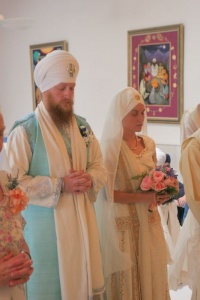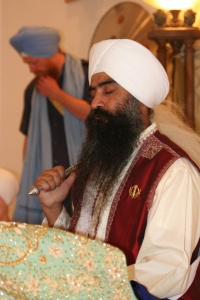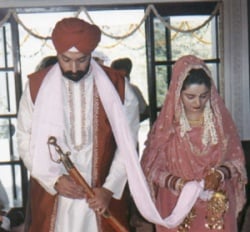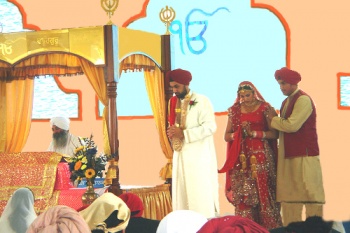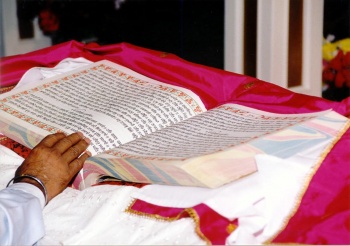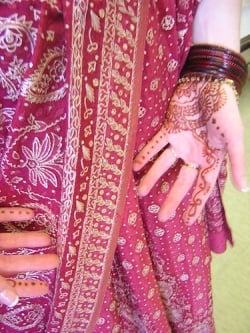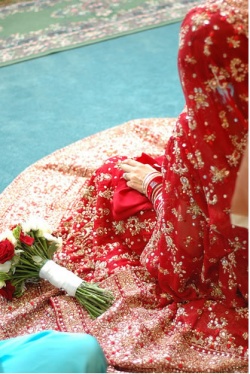Anand Karaj
| Part of a series on Sikh Practices |
| Sikhism |
| Sanskar |
| Sikh rites |
| Personal 5 Banis . Five ks |
Anand Karaj (Punjabi: ਅਨੰਦ s ਕਾਰਜ s , anand kāraj) is the name given to the Sikh wedding ceremony, literally translated as "Blissful Event". Sikhs regard marriage as a sacred bond of mutual dependence between a man and a woman; a true partnership of equals in marriage is made between those who are united in spirit as well as in mind and body. Marriage is regarded as a strong lifetime bond between the bride and groom and and a union between both the families of the bride and groom.
This event leads to a "joining" of the two families into one creating an enlarged extended family structure where each member has a useful part to play in the new family structure; each member of this extended family has to play a part in ensuring that the new couple are given every assistance in this new relationship and their start on this honourable path of Grist marg, "path of the householder".
Gristi jiwan (living as a householder) is given a very respected position in Guru Nanak's society as it is regarded as the essential basic atomic unit of a healthy community; a couple leading a happy, strong and fulfilling relationship will provide a base for a strong, united and coherent community.
More than a legal contract
Based on a concept depicted in Laava, the Sikh marriage is not merely a physical and legal contract but is a fusion of the souls; a holy union between two souls, where physically they appear as two individual bodies but in fact are united as one. The couple must feel and think alike and both must be completely identified with the other, i.e. they need to become "Ek Jot Doe Murti" meaning "one spirit in two bodies".
The Laava, or four stanzas, are read and then sung during the ceremony to formalize and sanctify the marriage. The Sikh religious wedding ceremony, which almost always these days takes place in a Gurdwara, the Sikh place of worship. The ceremony is held in the presence of Sri Guru Granth Sahib, the Sikh holy scripture and the Sadh sangat, the holy congregation.
This arrangement offers a way to bring family support into the lives of the couple if they require it. Guru Ram Das, the fourth Guru of the Sikhs has given, in the four rounds or Laava, a formula for a successful marriage. These four Shabads, describe the sacred journey of the soul through this world to the final destination, the merging with the infinite. If one follows this sacred path and applies it properly to the institution of marriage, it should results in happiness and fulfilment – Anand (Bliss).
This Sikh marriage ceremony demands a bit more from the couple than is normally expected. The Sikh Scriptures advice us that:
| ਮ: ੩ ॥ ਧਨ ਪਿਰੁ ਏਹਿ ਨ ਆਖੀਅਨਿ ਬਹਨਿ ਇਕਠੇ ਹੋਇ ॥ |
| mehlaa 3. Dhan pir ayhi na aakhee-an bahan ikthay ho-ay. |
| Third Mehl: They are not said to be husband and wife, who merely sit together. |
So, it is clear that the couple are only said to be married if they can portray that there is only "one light" in the two bodies.
Important features
The following are other important points that must be adhered to by the Sikh couple and their families:
- Both partners must be Sikhs.
- Marriage is a partnership of equals.
- No consideration is to be given to Caste, Social Status, Race or lineage.
- No Dowry is allowed.
- No day is considered holier than any other; No astrological considerations are to be made.
- The religious ceremony to take place in a Gurdwara or home of the Bride in the presence of Guru Granth Sahib.
- The religious ceremony must NOT take place in a hotel, wedding palace or Banqueting Hall.
- Burden of the cost of the wedding to be shared as equally as possible.
These days, the selection of the partners is left predominantly to the couple – with the families acting as supportive introduction service. However, in the past, the selection of the partners was left completely to the parents and other senior family members. This trend has slowly changed and communities will have varying attitudes to the selection process. Although, the ultimate choice of partners is always left to the would-be bride and groom, most couples will seek their parents consent and blessing.
The arrangements for the wedding are almost always undertaken by the parents of the couple, with the bride's side footing a larger slice of the total bill.
- Main article: Laava The Anand Karaj ceremony is joyous and festive event in which families and friends from both sides are heavily involved. The atmosphere is informal and lively. Most Sikh wedding take place in the morning but there are no restrictions as to what time the ceremony should start or end. The religious part of the ceremony lasts about 1 to 3 hours, depending on how important the families feel this is to their lives. The wedding event however will last for the whole day and may spill into the next day.
Most families combine the wedding ceremony with the engagement ceremony called the "Kurmai", where the Kurmai is held just before the wedding vows or Laava. The engagement ceremony can also be held as a separate event on a different day. It is usually conducted in the Gurdwara or at the home of the Groom-to-be. It involves Ardas, Kirtan , "Sagaan" (Exchange of gifts) and Langar. In the "Sagaan" ceremony, the groom is presented him with a kara, kirpan, Indian sweets, fresh fruits, dried fruits and nuts. The bride-to-be's family in turn are presented with garments and sweets for the Bride-to-be.
The Laava
The Four Rounds
The main part of the Anand Karaj is the reading and then the singing of each laav in turn. When the Laav is sung, the couple as a pair joint by a piece of cloth circle the SGGS. This has relevance to the occasion and should not be considered a ritual without meaning. When the couple circle the SGGS each time they making a commitment to God with the Guru as spiritual witness and support. And as one circles the Sri Guru Granth Sahib you are reminded that the Guru should be the center of your life, from which springs your spiritual guidance and understanding that you require for your souls long journey across this world ocean. The Sri Guru Granth Sahib is the center and the Sadh Sangat is your worldly witness and support.
The four nuptial rounds were written by Guru Ram Das for his own wedding. They explain the journey of the souls toward the Almighty. In them he tells us of the duties that a person undertaking a life of marriage should perform. In the first round, the Guru asks the partners to:
- commit to righteousness
- renounce sinful actions
- Remember, mediate and embrace Naam
- Only by good fortune, is real peace obtained
- Worship the one Waheguru and all your sins will vanish
In the second round, the Guru asks the partners to advance further towards meeting the True Guru - God:
- have fear of God and your ego will disappear
- Sing God's praises and feel His presence
- God is everywhere, outside and within, sing in Joy
In the third round, the Guru says that the partners mind is filled with "Divine Love":
- meeting the Sadh Sangat (Holy Congregation)
- which is only obtained by good fortune
- Recite Gurbani and sing the Glorious Praises of the Lord
- The Naam will vibrates and resounds within your heart
- and you will know your future destiny.
In the final round, the Guru says that the partners mind become peaceful and they will have found the Lord:
- God's Will seems sweet to these Gurmukhs.
- You will lovingly focus your consciousness on the Lord, day and night
- All your desires will be fulfilled
- The Souls will blend with Waheguru and only Naam will occupy your heart.
Summary of Procedure
- Departure of Barat and Reception of Barat
- Milnea (means "Introductions")
- Tea
- Main Wedding Ceremony (Anand Karaj)
- Kirtan
- Groom and then Bride come to the front
- Kirtan of the shabad Keetaa loree-ai kam
- Ardas & Speech by Giani
- Palaa. Palaa and Shabad Pallai Taiddai Laagee is sung by the ragi jatha
- Laava – 4 rounds where Granthi read and then Kirtaineea Sing.
- Kirtan of shabad Veeahu Hoa Mere Babula
- Final Kirtan of shabad Pooree Asa Jee Mansaa Mere Raam & Speech
- Ardas – All the congregation do final ardas
- Sagaan - Congregation bless the new couple
- Kara Parshad – Blessed "Sweet pudding" is served.
- Lunch or Langar
- Departure of Doli
- Reception (Optional - some Sikh Gurdwaras discourage this practice)
Detailed Analysis
ANAND KARAJ literally "joyful ceremonial occasion or proceedings" is the name given the SIKH marriage ceremony. For SIKHS married state is the norm and the ideal; through it, according to their belief, come the best opportunities for serving God's purpose and the well being of humanity, and it affords the best means of fulfilment of individuality and attainment of bliss. SIKHISM repudiates monkery, vows of celibacy, renunciation or the sannyasin state.
Unlike in the West, most marriages among Sikhs, as also in India as a whole, are arranged. It is regarded as a duty for the parents to arrange for and actively contribute towards the marriage of their offspring. Prem Sumarag, an eighteenth century work on Sikh social code, lays down: When a girl attains maturity, it is incumbent upon her parents to look for a suitable match for her. It is neither desirable nor proper to marry a girl at tender age. The daughter of a Sikh should be given in marriage to a Sikh. If a man is a believer in Sikhism, is humble by nature, and earns his bread by honest means, with him matrimony may be contracted without a question and without consideration for wealth and riches.
General customs
If he be a God fearing man, the parents should marry their daughter to him upon God's faith. God willing, their daughter will have all happiness and her parents will reap great satisfaction... whatever arrangements the parents make for a marriage these should be well within their means. They should not imitate ostentatious people. This is incumbent upon both sides. One who conducts the ceremony of marriage should not accept any gratification for it. Similarly, Sikh RAHIT MARYADA, manual of Sikh conduct and custom issued by the Shiromani Gurdwara Parbandhak Committee, statutorily elected representative society of the Sikhs, prescribes marriage of a Sikh girl only to a Sikh male without consideration of caste or sub caste.
It prohibits child marriage, permits widow remarriage, and enjoins that a Sikh marriage must be performed under Anand marriage rites. The Anand Marriage Act, 1909, (q.v.) gives legal recognition and validates marriages solemnized following this ceremony. Section 2, the operative part of the Act, reads: All marriages which may be or may have been duly solemnised according to the Sikh Marriage ceremony called Anand shall be and shall be deemed to have been with effect from the date of the solemnisation of each respectively good and valid in law.
Historical background
The history of Anand marriage ceremony is traced back to the time of GURU Amar Das (1479-1574), who composed the long 40 stanza hymn Anandu, in the Ramkali measure, suitable to be sung or recited on all occasions of religious import. His successor, Guru Ram Das, composed a four stanza hymn, Lavan, which is recited and sung to solemnize nuptials. During the time of Maharaja RANJIT SINGH and his successors, however, this ceremony fell into partial disuse under renewed Brahmanical influence at court as well as in society.
The Nirankari reform movement of the mid 19th century made the practice of Anand ceremony a vital plank in its programme as did the later, more widely influential Singh Sabha. But there was opposition from the Arya Samajis and Brahman priestly classes, the former anxious to prove that the Sikhs were but a sect of the Hindus and hence subject to Hindu Law, and the latter apprehensive of a reduction in their clientele and income. The Sikh form of wedding ceremonial eventually received legel sanction through the Anand Marriage Act which was adopted in 1909.
The ceremony is now universally observed by the Sikhs. According to Sikh Rahit Maryada, a formal engagement or betrothal prior to marriage is not absolutely necessary, but if the parties so desire, the betrothal ceremony takes place usually at the boy's residence where a few near relations of the girl go with some gifts, sweets and fruit. The gifts may include a ring or kara and kirpan for the prospective groom. They are handed over to him in the presence of relations, collaterals and friends assembled usually in SANGAT in the presence of Guru GRANTH Sahib.
Arrangements
The eatables include a chhuhara (dried date) of which the boy takes a bite signifying acceptance of the match as well as of the gifts. This ceremony concludes with sirvarna (money waved around the head of the boy in offering, given away thereafter in charity) and ARDAS (liturgical supplicatory prayer). Actual wedding takes place at the girl's residence. The date of the wedding is set by mutual consultation to suit both parties.
Astrological or horoscopic considerations are discountenanced in Sikh calculations. Matters such as the strength of the barat (the bridegroom's party), timing of arrival and departure, duration of stay, are also decided mutually so that the bride's parents may make suitable arrangements. Before setting out, the bridegroom may go to a gurdwara to make obeisance and offer ardas before the Guru Granth Sahib.
The main ceremony
On arrival at the house of the girl's parents, the party is received by the girl's parents, relations and friends outside the house with the chanting of hymns of welcome and ardas followed by milni or formal meeting of the two families, customarily restricted to the fathers (or guardians) and maternal uncles of the boy and the girl. Barat is then escorted inside for refreshments after which ANAND KARAJ takes place either in a gurdwara or under a marquee in the presence of the Guru Granth Sahib. This purely religious part of the proceedings commences with Kirtan, singing of hymns, as the guests and hosts assemble in sangat. The couple to be wed sit facing the Guru Granth Sahib, the bride on the left of the bridegroom.
Any Sikh chosen to conduct the ceremony will officiate. He will say a short opening ardas seeking felicity for the bridegroom and the bride, their respective parents or guardians only standing for this ardas with the rest of the sangat remaining seated. The choir will then sing a short hymn from the Guru Granth Sahib. Translated, the hymn would read: Call upon God for task thou wouldst have accomplished, He will bring the tasks to rights, so witnesseth the Guru. In the company of the holy thou shalt rejoice and taste only nectar, Thou art the demolisher of fear, thou art compassionate, O Lord, NANAK singeth the praises of the Incomputable Lord. (GG, 91) The officiant may then give a sermon addressed especially to the coupletobe explaining the significance of Sikh marriage and the duties and obligations of husband and wife towards each other and towards their families, community and society in general.
Marriage in Sikhism, he tells the couple-to-be, is not merely a civil or social contract but a union of the souls and rests upon mutual love and loyalty, mutual understanding and adjustment. A verse from Guru Amar Das, Nanak III, is often quoted: "They are not husband and wife who but sit side by side with each other; only they are truly wedded who personify one single soul in two bodies" (GG.788).
The 4 rounds
After the sermon the girl's father places one end of a scarf, usually saffron or pink in colour, in the groom's hand, passing it over his shoulder and placing the other end in the bride's hand, signifying that he had entrusted her to his protection. The musicians then sing another short hymn: Praise and slander have I all ceased to relish, 0 Nanak, False, I count all other relationships, To the fold of Thy fabric am I now affianced. (GG, 963) The Guru Granth Sahib is then opened at page 773 and the first stanza of the Lavan quartet is read from it.
The same stanza is then sung by the choir while the couple slowly and reverentially circumambulate the Holy Book, Guru Granth Sahib, clockwise, the bridegroom leading and the bride following, both continuing to hold their ends of the scarf throughout. They bow together before the Guru Granth Sahib before rising up for the circumambulation and again before resuming their seats on completing it. This process is repeated for each of the remaining three stanzas. The ceremony is concluded with the customary singing of the first five and the concluding hymn of Anand sahib followed by ardas, in which the whole congregation joins; vak or HUKAM (reading a verse from Guru Granth Sahib opened at random) is then received and karah prasad, the Sikh sacrament, distributed.
The Laava
- Main article: Laava
Translated into English the Lavari quartet or the Sikh epithalamium would read:
- 1. By the first nuptial circuiting The Lord sheweth ye His Ordinance for the daily duties of wedded life: The Scriptures are the Word of the Lord, Learn righteousness, through them, And the Lord will free ye from sin. Hold fast to righteousness, Contemplate the Name of the Lord, Fixing it in your memory as the scriptures have prescribed. Devote yourselves to the Perfect and True Guru. And all your sins shall depart. Fortunate are those whose minds Are imbued with the sweetness of His Name, To them happiness comes without effort; The slave Nanak proclaimeth That in the first circling The marriage rite hath begun.
- 2. By the second nuptial circumambulation Ye are to understand that the Lord Hath caused ye to meet the True Guru, The fear in your hearts has departed; The filth of selfness in your minds is washed away, By having the fear of God and by singing His praises I stand before Him with reverence, The Lord God is the soul of the universe! There is naught that He doth not pervade. Within us and without, there is One God only; In the company of saints Then are heard the songs of rejoicing. The slave Nanak proclaimeth That in the second circling Divine Music is heard.
- 3. In the third roundabout There is a longing for the Lord And detachment from the world. In the company of the saints, By our great good fortune, We encounter the Lord. The Lord is found in His purity Through His exaltation, Through the singing of His hymns. By great good fortune we have risen. In the company of the saints Wherein is told the story Of the Ineffable Lord. The Holy Name echoes in the heart: Echoes and absorbs us. We repeat the Name of the Lord, Being blessed by a fortunate destiny Written from of old on our foreheads. The slave Nanak proclaimeth That in the third circling The love of God has been awakened in the heart.
- 4. In the fourth walk around The mind reaches to knowledge of the Divine And God is innerly grasped: Through the Grace of the Guru We have attained with ease to the Lord; The sweetness of the Beloved Pervades us, body and soul. Dear and pleasing is the Lord to us: Night and day our minds are fixed on Him. By exalting the Lord We have attained the Lord: The fruit our hearts desired; The Beloved has finished His work. The soul, the spouse, delighteth in the Beloved's Name. Felicitations fill our minds; The Name rings in our hearts: The Lord God is united with His Holy Bride. The heart of the Bride flowers with His Name. The slave Nanak proclaimeth That in the fourth circling We have found the Eternal Lord. (GG, 773-74)
This completes the religious part of the ceremony. What follows is Punjabi cultural rituals and customs and do not in generally adhere to the strict Sikhi principles. However, they are included for general information about the cutural tradition of Punjabis and for general information only.
Post-Laava
After this and ahead lies a whole labyrinth of spectacular custom and rite. The dual sources of significance of Sikh marriage as an institution are:
- First, the doctrinal rules of the Sikh religious community, which are a few in number but universal in scope and intent; and
- Second, the traditional usages or customs of the PUNJABI ethnolinguistic community which are very many but confined to a particular social structure and associated with a particular territory or locality.
The prescribed marriage ritual, the anand karaj, is an expression of the basic principles of the faith. It was first given statutory recognition and thus officially and legally distinguished from the observances sanctioned under Hindu Customary Law, by the Anand Marriage Act of 1909.
According to Sikh rules, religious endogamy is essential, but not endogamy within the caste or sub caste group. Though customary rules of exogamy are held to prohibit the marriage of near consanguines, the precise position in this matter is difficult to determine and no ruling on this question is included in the Sikh code of conduct.
Other Rituals/Customs
NOTE: In reading this, please understand that most of the rituals described are cultural and have no affiliation with the Sikh religion (e.g. "chunni charhauna" or "chhuahara")
Broadly speaking, the marriage of a person within his or her own gotra (subcaste) is not permissible. There is a customarily sanctioned prejudice against a woman marrying her husband's younger brother. But all such prohibitions are of social rather than of religious nature. Such practices as the tying of head bands, rituals depicting ancestor worship, pretended sulking or sadness, singing by professional dancing girls, the drinking of alcohol, burning of so called sacred fires and similar superstitions derived from old religious practices are completely contrary to Sikh belief.
In some parts thaka is followed by another ceremony generally called chunni charhauna (the offering of the head scarf). In this ceremony the boy's parents send for the girl garments and gifts including a red thread (lal parandi) for plaiting the hair, a suite of clothes, some ornaments and cash. Before the marriage, a final engagement ceremony, known as shagan, kurmai or mangani takes place at the home of the boy's parents, when gifts are given by the girl's parents to the boy and to his close cognates.
A chhuhara (dried date) is offered to the boy by his would be father-in-law or his representatives to eat for which reason the ceremony is called in some parts chhuhara launa. The mangani can precede anand karaj by months, even years, especially when the boy and the girl get engaged at a very young age. A series of rites takes place separately in the home of the parents of the boy and the girl heralding nuptials. Maien paina is the period of seclusion from kindred and out siders observed by the boy and the girl for one to three days before the marriage.
The bride and the groom refrain from bathing or changing their clothes. During this period of ritual seclusion, the girl is not to use ornaments or cosmetics; manual work or going out alone is also not permitted. Singing of songs by womenfolk starts a day, or sometimes several days, before the wedding ceremony at the homes of the girl's as well as of the boy's parents. Songs mostly from Punjabi folklore are sung to the accompaniment of a dholak or drum. The songs for the groom are called ghorian (See: Sikh Ghorian)and those for the bride suhag.
On the eve of the day of marriage, the bride and the groom take the ritual bath which is called khare charhna, ascending the (bathing) basket. This is essentially a rite of purification following the state of seclusion. After the bath, both the boy and the girl put on new clothes specially prepared for the occasion. Generally these clothes are given by the respective nanake, that is, their maternal kin group.
Rituals before Anand karaj
Nanki Chhakk, etc
Again, these rituals are common in Punjabi weddings, but are not to be given importance according to the Sikh Rehat Maryada. In these Punjabi weddings, it is usual these days for the Nanki Chhakk to take place a day before the wedding. In this ceremony, the nanake give gifts to the girl called nanaki chhakk. These may consist of "ivory" bangles, a nose ring, a suite of clothes, or a set of ornaments and some household utensils and articles (again, this practice is irrelevant to the Sikh faith). The gifts may include clothes for the bride's parents and siblings. Gifts from (he maternal kin group are also given to the boy. These include clothes for the groom himself, for his parents and siblings and for his mother's brother.
Other customs
Several ceremonies take place before the groom sets off for the bride's home with the wedding party.
After the ardas is recited, in common Punjabi weddings, the boy's sister ties around his head a circlet with a plume and gilded strings hanging in front of his face. However, in true Sikh tradition, Sikh men are not to wear the "plume" which is a decoration worn strictly by the tenth Sikh Guru, Guru Gobind Singh Ji. Sirvarna (offering of money over the head of the groom) is performed, and the money distributed among the poor. According to these Punjabi traditions, a sister of the groom, to the accompaniment of songs, braids the mare's reins with red thread (mauli); a brother's wife puts black antimony powder (surma) in his eyes. Then, when all is ready, and the mare has been fed with barley and gram, the boy's sister seizes the reins of the mare and demands gift from her brother before allowing him to proceed.
The groom gives some money to all his sisters; this is called vag pharai (holding of the reins). As the procession starts a younger brother or nephew of the groom, acting as best man (sarvaha) is seated behind him on the mare.
Rituals after Anand karaj
NOTE: These rituals have no relevance to the Sikh faith and are simply cultural.
Before the groom departs with the bride, first the groom's party and then the bride's take lunch; the bride eats food provided by her parents-in-law and this is known as sauharian di rod. As the bride is about to leave her home, her mother, female relatives and close friends come out to see her off.
The band breaks into farewell songs. The bride and the groom leave together for the home of the latter's parents. The bride is usually accompanied by a younger brother, or traditionally, by the village barber's wife. This ceremony of the departure of the bride from her parents home is known as doli, a word denoting the litter which was formerly used as transport for the couple; nowadays a decorated car is usually provided for this purpose.
As the car or carriage starts off, the father of the groom showers small coins over it, thus expressing his happiness over the successful conclusion of the ceremony. A basket of sweets (bhaji), to be distributed to the groom's kin and friends, is sent along with the bride. The couple is ceremonially received at the entrance of the groom's family house.
Then follows the ritual of uncovering the bride's face (munh vikhai) in the presence of the female kin, friends and neighbours of the groom. The bride is fed with cooked dal and rice (Khichadi) signifying that she has become a member of her husband's household. She removes her veil [note: these are not Sikh practices; Sikh brides are not supposed to wear veils] and offers obeisance to the senior women kin who give her gifts of money after sirvarna (revolving money around the head).
The custom of giving a reception by the groom's parents is becoming popular in urban society although some Sikh institutes do not allow this. The reception is held after the marriage ceremony. Close kin and friends of both families are invited. A day or two later the bride usually returns to her parental home. Only after the groom fetches her from there for the second time, may the marriage be consummated.
This second trip is called muklava. On this occasion and on her subsequent visits to her parents home, her parents give her gifts of clothes and ornaments. The word denotes the gifts given at the time of the marriage to their daughter and to the groom's parents by the bride's parents. The gifts given to the bride by the groom's parents are called van.
Besides, giving the dowry (again this is strictly against Sikh principles), consisting of all the things that the bride will need to set up a household clothes, ornaments, utensils, furniture and beddings the bride's parents undertake expenses on the marriage ceremony, feasting, illuminations, etc. All this is not to be taken as constituting the Sikh marriage, but is the general practice in Punjabi society. Sikh reformers since the emergence of the Singh Sabha have been urging simple and inexpensive marriages strictly in accord with the spirit of the anand ceremony.
- Practises in some countries may vary. Please check with the hosts.
See Also
- Laava
- Other Wedding Shabads
- Attending a Sikh Wedding
- Sikh Wedding Booklets - Printable information about the Anand Karaj (Sikh Wedding)
- Visiting a Gurdwara
- Gurdwara
- Ghorian
- Sikhi against divorce
External Links
- Listen to collection of Anand Karaj shabads by Bhai Harjinder Singh (Sri Nagar Wale)
- An article in Nishan III 2006 by Dr. J.S.Neki on Anand Karaj...From counter-ritual to a legislative act
- An article pertaining to the ANAND KARAJ
- A simple and effective translation of Laava by Ek Ong Kaar Kaur Khalsa
- Details description of a Sikh Wedding from www.sikhs.org
- How to Perform the Anand Karaj
- Sikh Matrimonials Website
- Another Sikh Matrimonials Website
- www.sikh.net
- Anand Karaj - Marriage
- Indian Wedding - Sikhs
- Gateway to Sikhism
- The Sikh Marriage Ceremony - eBook
- panthic.org
- Sikhpoint.com Powerpoint presentation
- seasonsindia.com
References
- 1. Sikh Rahit Maryada. AMRITSAR, 1975
- 2. Randhir Singh, ed., Prem Sumarag Granth.Jalandhar, 1965
- 3. Jogendra Singh, Sikh Ceremonies. Chandigarh, 1968
- 4. Teja Singh, Sikhism: Its Ideals and Institutions. Bombay, 1938
- 5. Cole, W. Owen, and Piara Singh Sambhi, The Sikhs:

